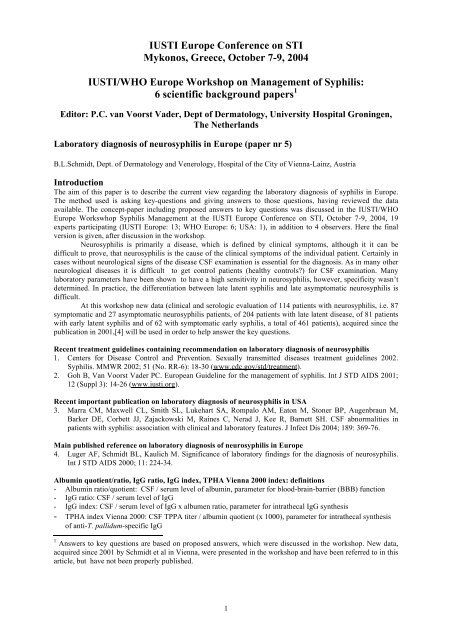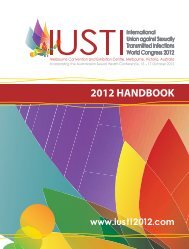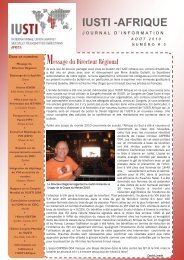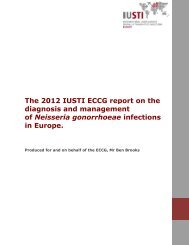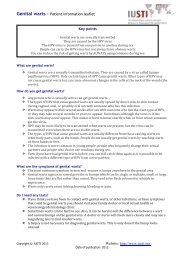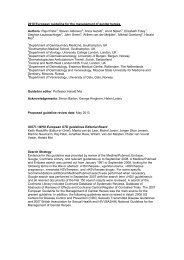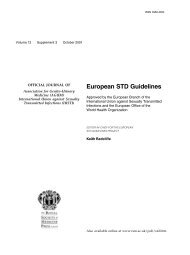5-Schmidt - neurosyphilis laboratory diagnosis - The International ...
5-Schmidt - neurosyphilis laboratory diagnosis - The International ...
5-Schmidt - neurosyphilis laboratory diagnosis - The International ...
Create successful ePaper yourself
Turn your PDF publications into a flip-book with our unique Google optimized e-Paper software.
IUSTI Europe Conference on STI<br />
Mykonos, Greece, October 7-9, 2004<br />
IUSTI/WHO Europe Workshop on Management of Syphilis:<br />
6 scientific background papers 1<br />
Editor: P.C. van Voorst Vader, Dept of Dermatology, University Hospital Groningen,<br />
<strong>The</strong> Netherlands<br />
Laboratory <strong>diagnosis</strong> of <strong>neurosyphilis</strong> in Europe (paper nr 5)<br />
B.L.<strong>Schmidt</strong>, Dept. of Dermatology and Venerology, Hospital of the City of Vienna-Lainz, Austria<br />
Introduction<br />
<strong>The</strong> aim of this paper is to describe the current view regarding the <strong>laboratory</strong> <strong>diagnosis</strong> of syphilis in Europe.<br />
<strong>The</strong> method used is asking key-questions and giving answers to those questions, having reviewed the data<br />
available. <strong>The</strong> concept-paper including proposed answers to key questions was discussed in the IUSTI/WHO<br />
Europe Workswhop Syphilis Management at the IUSTI Europe Conference on STI, October 7-9, 2004, 19<br />
experts participating (IUSTI Europe: 13; WHO Europe: 6; USA: 1), in addition to 4 observers. Here the final<br />
version is given, after discussion in the workshop.<br />
Neurosyphilis is primarily a disease, which is defined by clinical symptoms, although it it can be<br />
difficult to prove, that <strong>neurosyphilis</strong> is the cause of the clinical symptoms of the individual patient. Certainly in<br />
cases without neurological signs of the disease CSF examination is essential for the <strong>diagnosis</strong>. As in many other<br />
neurological diseases it is difficult to get control patients (healthy controls?) for CSF examination. Many<br />
<strong>laboratory</strong> parameters have been shown to have a high sensitivity in <strong>neurosyphilis</strong>, however, specificity wasn’t<br />
determined. In practice, the differentiation between late latent syphilis and late asymptomatic <strong>neurosyphilis</strong> is<br />
difficult.<br />
At this workshop new data (clinical and serologic evaluation of 114 patients with <strong>neurosyphilis</strong>, i.e. 87<br />
symptomatic and 27 asymptomatic <strong>neurosyphilis</strong> patients, of 204 patients with late latent disease, of 81 patients<br />
with early latent syphilis and of 62 with symptomatic early syphilis, a total of 461 patients), acquired since the<br />
publication in 2001,[4] will be used in order to help answer the key questions.<br />
Recent treatment guidelines containing recommendation on <strong>laboratory</strong> <strong>diagnosis</strong> of <strong>neurosyphilis</strong><br />
1. Centers for Disease Control and Prevention. Sexually transmitted diseases treatment guidelines 2002.<br />
Syphilis. MMWR 2002; 51 (No. RR-6): 18-30 (www.cdc.gov/std/treatment).<br />
2. Goh B, Van Voorst Vader PC. European Guideline for the management of syphilis. Int J STD AIDS 2001;<br />
12 (Suppl 3): 14-26 (www.iusti.org).<br />
Recent important publication on <strong>laboratory</strong> <strong>diagnosis</strong> of <strong>neurosyphilis</strong> in USA<br />
3. Marra CM, Maxwell CL, Smith SL, Lukehart SA, Rompalo AM, Eaton M, Stoner BP, Augenbraun M,<br />
Barker DE, Corbett JJ, Zajackowski M, Raines C, Nerad J, Kee R, Barnett SH. CSF abnormalities in<br />
patients with syphilis: association with clinical and <strong>laboratory</strong> features. J Infect Dis 2004; 189: 369-76.<br />
Main published reference on <strong>laboratory</strong> <strong>diagnosis</strong> of <strong>neurosyphilis</strong> in Europe<br />
4. Luger AF, <strong>Schmidt</strong> BL, Kaulich M. Significance of <strong>laboratory</strong> findings for the <strong>diagnosis</strong> of <strong>neurosyphilis</strong>.<br />
Int J STD AIDS 2000; 11: 224-34.<br />
Albumin quotient/ratio, IgG ratio, IgG index, TPHA Vienna 2000 index: definitions<br />
- Albumin ratio/quotient: CSF / serum level of albumin, parameter for blood-brain-barrier (BBB) function<br />
- IgG ratio: CSF / serum level of IgG<br />
- IgG index: CSF / serum level of IgG x albumen ratio, parameter for intrathecal IgG synthesis<br />
- TPHA index Vienna 2000: CSF TPPA titer / albumin quotient (x 1000), parameter for intrathecal synthesis<br />
of anti-T. pallidum-specific IgG<br />
1 Answers to key questions are based on proposed answers, which were discussed in the workshop. New data,<br />
acquired since 2001 by <strong>Schmidt</strong> et al in Vienna, were presented in the workshop and have been referred to in this<br />
article, but have not been properly published.<br />
1
A. Laboratory <strong>diagnosis</strong> of <strong>neurosyphilis</strong> (examination of cerebrospinal fluid (CSF)): recommendations<br />
of the American CDC STD guidelines, ed. 2002.[1]<br />
a) CSF-VDRL test (if positive, in the absence of blood contamination: definite <strong>neurosyphilis</strong>; however: the<br />
CSF-VDRL test may be negative when <strong>neurosyphilis</strong> is present);<br />
b) CSF FTA-absorption test (according to some experts a negative test excludes <strong>neurosyphilis</strong>);<br />
c) CSF leukocyte count is usually elevated in <strong>neurosyphilis</strong> (>5 WBC/mm 3 );<br />
d) CSF protein level.<br />
B. Laboratory <strong>diagnosis</strong> of <strong>neurosyphilis</strong> (examination of cerebrospinal fluid (CSF)): recommendations of<br />
the European STD guidelines, ed. 2001,[2] updated for the Syphilis Workshop IUSTI/WHO workshop<br />
2004<br />
• Lumbar puncture for examination of cerebrospinal fluid (CSF) is indicated in patients with:<br />
- clinical neurological symptoms possibly caused by <strong>neurosyphilis</strong><br />
• Lumbar puncture for examination of cerebrospinal fluid (CSF) should be considered in patients with:<br />
- clinical symptoms possibly caused by ocular or auricular syphilis<br />
- clinical symptoms possibly caused by cardiovascular or gummatous syphilis<br />
- concomitant HIV infection*<br />
* For non-HIV-infected patients with late latent syphilis or latent syphilis of unknown duration CSF<br />
examination is an option. This examination is intended to exclude asymptomatic <strong>neurosyphilis</strong>, although the<br />
benefit may be marginal and the need minimal, as the risk of developing symptomatic <strong>neurosyphilis</strong> after<br />
standard parenteral treatment appears to be small in such patients.<br />
For management of HIV-positive patients with late latent syphilis or latent syphilis of unknown<br />
duration there are two options at present (anno 2004; see paper nr 4: M.Janier, “Syphilis and HIV-infection:<br />
the European view”, key question 4: “Should cerebrospinal fluid (CSF) examination be performed in HIVpositive<br />
patients with late latent syphilis or latent syphilis of unknown duration?”; and paper nr 3: R.Parkes<br />
and P.C. van Voorst Vader, “Treatment of syphilis: the European view”, key question 3: “Is BBP 2.4 MU<br />
im on day 1, 8 and 15 sufficiently effective in late latent syphilis and is there an indicaton for CSF<br />
examination in late latent HIV-infected syphilis patients before treatment?”):<br />
1) CSF examination to exclude asymptomatic <strong>neurosyphilis</strong> (having clinically excluded symptomatic<br />
<strong>neurosyphilis</strong>, including auricular and ocular syphilis), possibly using criteria as non-treponemal serum RPR<br />
(or VDRL) test titre ≥ 1:32 and CD4+ cell count < 350/µL for patients at risk for asymptomatic<br />
<strong>neurosyphilis</strong>, followed by i.v. penicillin (or possibly cefriaxone) treatment, if asymptomatic <strong>neurosyphilis</strong><br />
is diagnosed in order to prevent the development of symptomatic <strong>neurosyphilis</strong>;[3] an additional criterion<br />
might be a quantitative TPHA, as our investigations in Vienna showed, that a serum TPHA titer
• IgM-index (parameter for intrathecal IgM synthesis; normal value: 10/mm 3 in CSF)<br />
plus<br />
IgG-index ≥ 0.70 (in CSF)<br />
or<br />
positive VDRL test (in CSF)<br />
or<br />
TPHA-index Vienna 2000 >70*<br />
* TPHA-index (Vienna 2000) >70: <strong>neurosyphilis</strong> highly probable.[4, and additional data from the Vienna<br />
center since 2001]<br />
• Other considerations<br />
- A positive TPHA/TPPA or FTA-abs. test in CSF by itself does not confirm the <strong>diagnosis</strong> <strong>neurosyphilis</strong>,<br />
but a negative treponemal CSF test excludes <strong>neurosyphilis</strong>. As the CSF FTA-abs. test may be false<br />
positive, the TPHA/TPPA should be preferred.[5,6]<br />
- Finding in CSF a positive TPHA/TPPA, an increased number of mononuclear cells and a raised IgGand/or<br />
IgM-index only provides circumstantial evidence for the <strong>diagnosis</strong> <strong>neurosyphilis</strong>. A positive<br />
CSF-VDRL test as well as a TPHA-index Vienna 2000 >70 are seen as providing more direct evidence<br />
for the <strong>diagnosis</strong> <strong>neurosyphilis</strong>, the sensitivity of the CSF-VDRL test being circa 85% (or lower) and of<br />
the TPHA-index Vienna 2004 >98% (data reported in this article).<br />
- <strong>The</strong> CSF VDRL test can be negative in <strong>neurosyphilis</strong>.<br />
- A CSF-TPHA titer >1:320 is indicative of <strong>neurosyphilis</strong> (found in 59/60, i.e. 98.3%, <strong>neurosyphilis</strong><br />
patients), thus a CSF-TPHA titer 99%, <strong>neurosyphilis</strong> patients, but the IgG-index is generally elevated in any infectious disease with<br />
Central Nervous System (CNS) involvement).<br />
- <strong>The</strong> number of mononuclear cells in CSF can be normal in <strong>neurosyphilis</strong>, especially in parenchymatous<br />
<strong>neurosyphilis</strong> (late syphilis: tabes dorsalis, general paresis).<br />
- Tests may be performed for the presence of HIV-RNA or HIV-p24 Ag in CSF of HIV-infected<br />
individuals, which indicate HIV-infection of the central nervous system.<br />
- <strong>The</strong> criteria outlined above (except the CSF-VDRL test) have not been validated in HIV-seropositive<br />
patients.<br />
3
- CSF abnormalities suggestive of asymptomatic <strong>neurosyphilis</strong> occur in about 20-30% of patients with<br />
early syphilis,[7,8] but the clinical relevance of that finding is very limited, as standard treatment for<br />
early syphilis is very effective.<br />
Key question 1. How valid is a positive CSF-VDRL for diagnosing <strong>neurosyphilis</strong>?<br />
A positive CSF-VDRL test is included in the CDC recommendations for <strong>neurosyphilis</strong> besides a CSF-protein<br />
value of > 0,45 g/L and pleiocytosis (> 5 cells/mm 3 ).[1] <strong>The</strong> specificity is nearly 100%. Sensitivity however was<br />
between 30 and 80%.[9-11] In one of the larger studies, including 241 patients with <strong>neurosyphilis</strong>, the CSF-<br />
VDRL test was reactive in 43 % of patients.[10] Most of the studies published during recent years in the US<br />
defined <strong>neurosyphilis</strong> by a reactive CSF-VDRL test and were unable to check the sensitivity of the test.[13,14]<br />
We found 15 non-reactive CSF-VDRL test patients (6/15 asymptomatic) with <strong>neurosyphilis</strong>. Thus the sensitivity<br />
of a positive CSF-VDRL test for the <strong>diagnosis</strong> of <strong>neurosyphilis</strong> was 87%; the <strong>diagnosis</strong> <strong>neurosyphilis</strong> was<br />
missed by that criterion in 6/27 (22%) asymptomatic patients and in 9/87 (10%) symptomatic patients.<br />
Answer: A negative CSF-VDRL test does not exclude <strong>neurosyphilis</strong>. Additional tests for determining intrathecal<br />
production of specific (treponemal) antibodies are recommended.<br />
Key question 2. How valid is a treponemal CSF test (TPHA/TPPA or FTA-abs. test) for diagnosing<br />
<strong>neurosyphilis</strong>?<br />
A negative treponemal CSF test (TPHA/TPPA or FTA-abs. test) excludes <strong>neurosyphilis</strong>.[3,5] As the CSF FTAabs.<br />
test may be false positive, the TPHA/TPPA should be preferred.[5,6] A CSF-TPHA titer >1:320 is<br />
indicative of <strong>neurosyphilis</strong> (found in 59/60, i.e. 98.3%, <strong>neurosyphilis</strong> patients).[4] In 204 late latent syphilis<br />
patients a CSF-TPHA titre >1:80 was found in 9%, a CSF-TPHA titre >1:160 in 1.5%.<br />
Answer: A negative treponemal CSF test (TPHA/TPPA or FTA-abs. test) excludes <strong>neurosyphilis</strong>. <strong>The</strong> CSF-<br />
TPHA/TPPA should be preferred above the CSF-FTA-abs. test. A CSF-TPHA titre >1:320 is highly suggestive<br />
of the <strong>diagnosis</strong> <strong>neurosyphilis</strong>.<br />
Key question 3. How valid is the TPHA-index Vienna 2000 for diagnosing <strong>neurosyphilis</strong>?<br />
<strong>The</strong> production of intrathecally synthesized antibodies can be measured by various indices, by which the amount<br />
of treponemal antibodies in CSF and in serum is related to either whole IgG (intrathecal T. pallidum antibody<br />
(ITPA) index, i.e. a treponemal antibody index with relative specific activity) or to the albumin quotient<br />
(TPHA-index, modified TPHA-index (mHA), MHA-TP index, i.e. treponemal antigen indices). Differences<br />
between these indices are mainly due to methodological aspects.[4] <strong>The</strong> sensitivity of all these indices is higher<br />
than that of the CSF-VDRL test. What is more important: in all 15 CSF-VDRL test negative patients<br />
intrathecally produced treponemal antibodies could be demonstrated by all indices applied. Using the TPHAindex<br />
Vienna 2000 (>70: <strong>neurosyphilis</strong> highly probable), the index with the highest sensitivity, the <strong>diagnosis</strong><br />
<strong>neurosyphilis</strong> was missed in 1/114 patients (sensitivity 100% in asymptomatic <strong>neurosyphilis</strong>, 98,6% in<br />
symptomatic <strong>neurosyphilis</strong>). Specificity of the TPHA-index Vienna is very high, it being a specific treponemal<br />
test. Whether neuroborreliosis interferes with specificity is unknown. <strong>The</strong> cut-off value of the TPHA-index<br />
Vienna 2000 (>70) did not appear to be influenced by using the TPPA instead of the TPHA in late latent syphilis<br />
patients, according to the experience in the Vienna center. Confirmation of the value of the TPHA/TPPA-index<br />
Vienna 2000 by another group would be commendable. <strong>The</strong>re are scarce data on the use of this test in HIVinfected<br />
patients.<br />
Answer: Measurement of intrathecally produced treponemal antibodies is more sensitive than the CSF-VDRL<br />
test and a specific index (preferentially the TPHA-index Vienna 2000) can be helpful for the <strong>laboratory</strong><br />
<strong>diagnosis</strong> of <strong>neurosyphilis</strong>. <strong>The</strong> cut-off value( >70) did not appear to be influenced by using the TPPA instead of<br />
the TPHA. Confirmation of the value of the TPHA/TPPA-index Vienna 2000 by another group would be<br />
commendable.<br />
Key question 4. How valid is CSF pleiocytosis for diagnosing <strong>neurosyphilis</strong>?<br />
Determination of the CSF leukocyte (WBC) count, i.e. of the number of mononuclear cells, parameter for active<br />
cellular inflammation, is the most important for defining meningeal involvement. It is generally high in<br />
meningovascular <strong>neurosyphilis</strong>, but can be low in parenchymatous or asymptomatic <strong>neurosyphilis</strong>. We found >4<br />
cells/mm 3 in 110/114 (96 %) <strong>neurosyphilis</strong> patients, but also an elevated CSF leukocyte count in 13% of 204 late<br />
latent patients and in 8% of 81 early latent patients. <strong>The</strong> sensitivity of CSF pleiocytosis for diagnosing<br />
<strong>neurosyphilis</strong> was found by Hoosmand et al. to be 82%.[12] A higher cut-off value (not 5, but 10 cells/mm 3 )<br />
increases specificity but decreases sensitivity. <strong>The</strong> CSF leukocyte count is the main parameter for measuring the<br />
treatment response using CSF examination.<br />
4
Answer: Determination of the CSF leukocyte (WBC) count, i.e. of the number of mononuclear cells, is a routine<br />
parameter in every neurological department. Despite the fact, that it is a non-specific parameter, it should be<br />
included for the <strong>laboratory</strong> <strong>diagnosis</strong> of <strong>neurosyphilis</strong>, as it is the main parameter for active inflammation.<br />
Key question 5. How valid is CSF protein for diagnosing <strong>neurosyphilis</strong>?<br />
Elevated CSF protein ( > 0,45 g/L) is one of the non-specific parameters indicating inflammation of the brain.<br />
We found elevated CSF protein in 113/114 patients with <strong>neurosyphilis</strong>, but also in 14% of 204 patients with late<br />
latent disease. In the study by Hoosmand et al. only 39% had elevated values.[12] After treatment decline of CSF<br />
protein is slow.<br />
Answer: CSF protein (parameter for inflammation) belongs to the standard CSF tests in neurology and is<br />
generally done with every sample. However, CSF protein is of little help in diagnosing <strong>neurosyphilis</strong>.<br />
Key question 6. How valid is the albumin quotient for diagnosing <strong>neurosyphilis</strong>?<br />
<strong>The</strong> ratio/quotient of CSF/serum albumin is a measure of the blood-brain barrier (BBB) function. Normal values<br />
are age dependent and generally
is rapid and values 1:320, however, indicates <strong>neurosyphilis</strong>. Most important, a negative treponemal CSF test does<br />
exclude <strong>neurosyphilis</strong>. <strong>The</strong> CSF-VDRL test lacks sensitivity, but specificity is high. All treponemal indices have<br />
a higher sensitivity than the CSF-VDRL test. Such a test, preferably the TPHA-index Vienna 2000, being the<br />
most sensitive test in the Vienna experience, can be helpful in the <strong>laboratory</strong> <strong>diagnosis</strong> of <strong>neurosyphilis</strong>.<br />
Answer: a) CSF leukocyte (i.e. mononuclear cell) count (parameter for inflammation, main parameter for<br />
monitoring treatment response); b) albumin quotient (parameter for blood-brain-barier function and necessary<br />
for measuring IgG-index and treponemal antibody index); c) IgG-index (measure for intrathecal non-specific<br />
antibody production, more sensitive than CSF protein); d) CSF-TPHA (if negative, <strong>neurosyphilis</strong> is excluded; if<br />
titer >1:320, <strong>neurosyphilis</strong> is highly likely); e) TPHA-index Vienna 2000 (may be helpful; measure for<br />
intrathecal specific antitreponemal antibody production; if >70: <strong>neurosyphilis</strong> highly probable). For albumin<br />
quotient and IgG-index a serum sample is needed besides a CSF sample.<br />
Key question 12. What is the importance of diagnosing asymptomatic <strong>neurosyphilis</strong> in patients with late<br />
latent syphilis or latent syphilis of unknown duration and in patients with early syphilis with symptomatic<br />
ocular or auricular syphilis?<br />
<strong>The</strong> American syphilis guideline 2002 recommends prompt CSF examination in patients with latent syphilis,<br />
who demonstrate any of the following criteria:[1] a) neurologic or ocular signs or symptoms; b) evidence of<br />
tertiary syphilis (e.g. aortitis, gumma, iritis); c) treatment failure; d) HIV-infection with late latent syphilis or<br />
syphilis of unknown duration.<br />
<strong>The</strong> European syphilis guideline 2001 recommends CSF examination for patients with:[2] a) clinical<br />
evidence of neurological involvement; b) ocular, cardiovascular or gummatous syphilis; c) concomitant HIV<br />
infection.<br />
<strong>The</strong> European syphilis guideline 2001 and the American CDC syphilis guideline 2002 and also<br />
Rompalo’s 2004 “Update on syphilis and HIV” thus recommend CSF examination before treatment in HIVinfected<br />
patients with late latent syphilis or latent syphilis of unknown duration.[1,2,22] Hard data on the<br />
magnitude of the risk of developing symptomatic <strong>neurosyphilis</strong> from asymptomatic <strong>neurosyphilis</strong> after standard<br />
treatment with BBP 2.4 MU i.m. on day 1, 8 and 15 in these patients were not given though. <strong>The</strong> risk of<br />
asymptomatic <strong>neurosyphilis</strong> as diagnosed by a positive CSF VDRL test appears to be increased in patients dually<br />
infected with HIV and syphilis, but does that result in a risk of symptomatic <strong>neurosyphilis</strong> of such magnitude<br />
that standard CSF examination should be recommended of HIV-infected patients with late latent syphilis or<br />
latent syphilis of unknown duration? That strategy may not be cost-effective and leads to finding CSF<br />
abnormalities (concurrent HIV-infection!), which are difficult to interpret.[23,24] Criteria as non-treponemal<br />
serum RPR (or VDRL) test titre ≥ 1:32 and CD4+ cell count < 350/µL may increase the risk for asymptomatic<br />
<strong>neurosyphilis</strong> and help selecting patients for elective CSF examination.[3] An additional criterion might be a<br />
quantitative TPHA, as investigations in the Vienna center showed, that a serum TPPA titer
For further information, see: a) paper nr 2: R. Parkes and P.C. van Voorst Vader, “Treatment of<br />
syphilis: the European view”, key question 3:”Is BBP 2.4 MU i.m. on day 1, 8 and 15 sufficiently effective in<br />
late latent syphilis and is there an indication for CSF examination in HIV-infected patients with late latent<br />
syphilis or syphilis of unknown duration before treatment?”; b) paper nr 3: P. French, “Serologic follow-up after<br />
treatment for syphilis in Europe”, key question 5: “How should HIV-negative and HIV-positive individuals with<br />
an inadequate serologic response after treatment of late latent syphilis be managed?”; c) paper nr 4: M.Janier,<br />
“Syphilis and HIV-infection: the European view”, key question 4: “Should CSF examination be performed in<br />
HIV-positive patients with late latent syphilis or latent syphilis of unknown duration?”.<br />
Answer: European 2001 and American 2002 syphilis guidelines recommend CSF examination before treatment<br />
in HIV-infected patients with late latent syphilis or latent syphilis of unknown duration to exclude asymptomatic<br />
<strong>neurosyphilis</strong>, but there are no hard data on the magnitude of the risk of developing symptomatic <strong>neurosyphilis</strong><br />
after standard BBP treatment on day 1, 8 and 15 of these patients. If CSF examination is not performed, an<br />
alternative option is clinical and serologic follow-up of these patients during 1-2 years after treatment or longer,<br />
which is generally performed at HIV-clinics because of the HIV-infection, and instruction when to contact the<br />
physician. CSF examination is indicated in patients with symptoms possibly caused by <strong>neurosyphilis</strong>, but is not<br />
essential in patients with symptomatic ocular or auricular syphilis (without other symptoms of CNS<br />
involvement), if they are treated with i.v. penicillin.<br />
References 5-22<br />
5. Jaffe HW, Larsen S, Peters M, Franco Jove D, Lopez B, Schroeter AL. Tests for treponemal antibody in<br />
CSF. Arch Intern Med 1978; 138: 252-5.<br />
6. Breustedt W, Bitta R, Sonnichsen N. Positive FTA-Abs test in CSF of non-syphilitic persons infected<br />
with HIV. Arch Dermatol 1989; 125: 1712.<br />
7. Löwhagen GB, Andersson M, Blomstrand C, Roupe G. Central nervous system involvement in early<br />
syphilis. Part I. Intrathecal immunoglobulin production. Acta Derm Venereol (Stockh) 1983; 63: 409-<br />
17.<br />
8. Lukehart SA, Hook EW, Baker-Zander SA, Colllier AC, Critchlow CW, Handsfield HH. Invasion of<br />
the CNS by T. pallidum. Implications for <strong>diagnosis</strong> and treatment. Ann Intern Med 1988; 109: 855-62.<br />
9. Hook EW, Marra CM. Acquired syphilis in adults. N Engl J Med 1992; 326: 1060-9.<br />
10. Larsen SA, Steiner BM, Rudolph AH. Laboratory <strong>diagnosis</strong> and interpretation of tests for syphilis. Clin<br />
Microbiol Rev 1995; 8: 1-21.<br />
11. Lukehart SA, Hook EW, Baker-Zander SA, Colllier AC, Critchlow CW, Handsfield HH. Invasion of<br />
the CNS by T. pallidum. Implications for <strong>diagnosis</strong> and treatment. Ann Intern Med 1988; 109: 855-62.<br />
12. Hooshmand H, Escobar MR, Kopf SW. Neurosyphilis. A study of 241 patients. JAMA 1972; 219: 726-<br />
9.<br />
13. Flood JM, Weinstock HS, Guroy ME, Bayne L, Simon RP, Bolan G. Neurosyphilis during the AIDS<br />
epidemic, San Francisco, 1985-1992. J Infect Dis 1998; 177: 931-40.<br />
14. Marra CM, Tantalo LC, Maxwell CL,Dougherty K, Wood B. Alternative cerebrospinal fluid tests to<br />
diagnose <strong>neurosyphilis</strong> in HIV-infected individuals. Neurology 2004; 13: 85-8.<br />
15. Moskophidis M, Müller F. Intrathekale synthese Treponema pallidum spezifischer IgG- und IgMantikörper.<br />
Immun Infekt 1985; 13: 91-8.<br />
16. Van Eijk RVW, Wolters ECh, Tutuarima JA, Hische EAH, Bos JD, Van Trotsenburg L, De Koning<br />
GAJ, Van der Helm HJ. Effect of early and late syphilis on central nervous system: cerebrospinal fluid<br />
changes and neurological deficit. Genitourin Med 1987; 63: 77-82.<br />
17. Luger A, <strong>Schmidt</strong> BL, Steyrer K, Schönwald E. Diagnosis of <strong>neurosyphilis</strong> by examination of the<br />
cerebrospinal fluid. Br J Vener Dis 1981; 57: 232-7.<br />
18. Noordhoek GT, Wolters EC, De Jonge MEJ, Van Embden DA. Detection by PCR of Treponema<br />
pallidum DNA in CSF from <strong>neurosyphilis</strong> patients before and after antibiotic treatment. Jclin Microbiol<br />
1991; 29: 1976-84.<br />
19. Rolfs RT, Joesoef MR, Hendershot EF, Rompalo AM, Augenbraun MH, Chiu M, et al. A randomised<br />
trial of enhanced therapy for early syphilis in patients with and without HIV infection. New Engl J Med<br />
1997; 337: 307-14.<br />
20. Romanowski B, Sutherland R, Fick GH, Mooney D, Love EJ. Serologic response to treatment of<br />
infectious syphilis. Ann Int Med 1991; 114: 1005-9.<br />
21. Marra CM, Maxwell CL, Tantalo L, Eaton M, Rompalo AM, Raines C, Stoner BP, Corbett JJ,<br />
Augenbraun M, Zajackowski M, Kee R, Lukehart SA. Normalization of cerebrospinal fluid<br />
abnormalities after <strong>neurosyphilis</strong> therapy: does HIV status matter? Clin Infect Dis 2004; 38: 1001-6.<br />
22. Rompalo A. Treatment and prevention of syphilis in the HIV-infected patient. 2004;<br />
www.uptodate.com<br />
23. Wiesel J, Rose D, Silver A, Sacks H, Bernstein R. Lumbar puncture in asymptomatic late syphilis: an<br />
analysis of the benefits and risks. Arch Intern Med 1985; 145: 465-8.<br />
7
24. Carey LA, Glesby MJ, Mundy LM, Janis EM, Hook EW. Lumbar puncture for evaluation of latent<br />
syphilis in hospitalized patients: high prevalence of cerebrospinal fluid abnormalities unrelated to<br />
syphilis. Arch Intern Med 1995; 155: 1657-62.<br />
8


